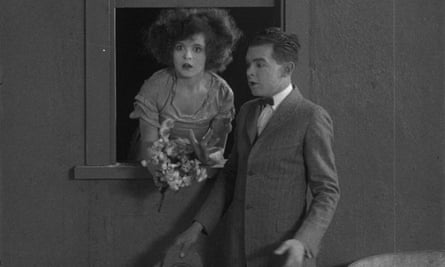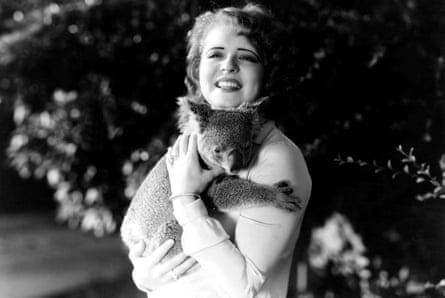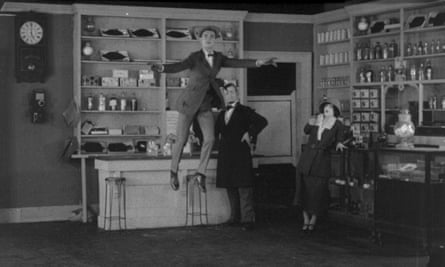A century after she first began to turn heads, Clara Bow is “It” once more. The iconic flapper of the silent film era inspired Margot Robbie’s character Nellie in Damien Chazelle’s Hollywood epic Babylon, is namechecked on Taylor Swift’s forthcoming album The Tortured Poets Department, and yesterday at the San Francisco Silent film festival, one of her earliest films was shown for the first time since the days of bathtub gin.
The story of the film’s discovery has already caused excitement online. Film-maker Gary Huggins inadvertently snapped up a slice of lost silent film history at an auction in a car park in Omaha, Nebraska, that was selling old stock from a distribution company called Modern Sound Pictures. Hoping to bid on a copy of the 1926 comedy Eve’s Leaves that he had spotted on top of a pile, Huggins was informed that he could only buy the whole pallet of movies, not individual cans. The upside? The lot was his for only $20.

Huggins soon discovered that his new pile of reels included 1923’s The Pill Pounder, a silent comedy that had been thought to be lost for decades. It is a short, two-reel film, shot in Long Island, New York, and directed by Gregory La Cava, best known for later classics such as My Man Godfrey (1936) and Stage Door (1937). The film stars rubber-faced vaudeville veteran Charlie Murray, the so-called “Irish comedian” who was actually from Laurel, Indiana. He plays a hapless pharmacist, the “pill pounder” of the title, who is trying to host a clandestine poker game in the back room of his drugstore. What few realised until Huggins watched the film, was that it also features 17-year-old Bow in a supporting role. She plays the girlfriend of Murray’s son, played by James Turfler, who had already appeared with Bow in her second film Down to the Sea in Ships, directed by Elmer Clifton and screened in 1922. Turfler’s character is the butt of some bizarre gags. At one point, he chugs a jug of effervescent “fomo seltzer” and Bow watches in horror as he floats up to the ceiling.
In this, one of her earliest surviving performances on film, Bow looks even younger than her years. Although she lacks the sleek Hollywood glamour she later acquired, she has the charisma to turn a thankless bit-part into something of a scene-stealer. The critics took note: based on the evidence of this film, the Exhibitors’ Trade Review described her as “perhaps the most promising of the younger actresses”. In his introduction to the film at San Francisco’s grand Palace of Fine Arts theatre, Bow’s biographer, the screenwriter David Stenn, speculated that the actor may have forgotten that she made the film, as she never talked about it. It was made during a traumatic period in her life, only a few weeks after her mother’s death following prolonged mental illness. He invited us to imagine how Bow might have felt appearing in a lighthearted slapstick comedy in such circumstances.
The film, which has been restored by the festival’s organisers and was screened with accompanying music from composer Wayne Barker, now looks remarkably good for its age. The festival’s senior film restorer, Kathy Rose O’Regan, said it was in great shape when they received it. She added: “We imagined it was screened maybe a few times, but there’s hardly any damage – a few scratches here and there, some dirt, but overall in pretty stellar condition.”

Now it has been freshened up and looks its best, but it is still incomplete, being in what Stenn called a “beta version”.
That’s because the copy Huggins found was not from the 1920s, but a 35mm print from the 1950s or 1960s of an edit of the film that was destined to become part of a 16mm compilation of old silent films with a comic voiceover poking fun at its archaic aspects. The intertitles have been removed and there are a few scenes and shots missing, too.
This process is deeply unflattering to old movies, but it has been responsible for preserving versions of silent films that would otherwise have been lost, including the Lois Weber melodrama Shoes from 1916. And the lack of titles are no barrier to following the film.
“For me, it is a pretty perfect 14-minutes of fun,” says O’Regan. “It would be nice to know what the titles were, but you can certainly get the gist without them.”

Stenn called the tale of the film’s discovery “miraculous” and led a round of applause for Huggins, who was in the audience. He explained that there was reason to believe that some of the discarded material was among the other cans that were sold at the Omaha auction. The hunt is on to round out The Pill Pounder, and several people have joined in the search, combing through thousands of reels. One Omaha-based film-maker and silent film enthusiast, Alexander Payne, was quick to offer his support.
The film fills in a brief blank period in Bow’s filmography. She shot the role – probably in just a couple of days – in the early “false start” phase of her film career. Bow, a tomboy from a troubled home in Brooklyn, made her debut after winning a magazine talent competition in 1921 but struggled to get her career off the ground.
after newsletter promotion
“I wore myself out goin’ from studio t’studio, from agency t’agency, applyin’ for every possible part,” she later recalled. “But there was always something. I was too young, or too little, or too fat. Usually I was too fat.”
In 1923, she found her way into a handful of films, including The Pill Pounder, where she had the chance to shine in supporting roles, and this is when she finally got her ticket to Hollywood and Paramount.
“She’s not the star of the film, but you can’t take her eyes off her,” says O’Regan. “For the few minutes she’s there she’s divine, she’s fun, she’s full of energy.”

The festival screened The Pill Pounder alongside another new restoration. The feature film Dancing Mothers directed by Herbert Brenon in 1926, is a flapper drama that Bow made for Paramount, in one of her last supporting roles. She plays the reckless daughter of a lonely woman (Alice Joyce) who tires of staying home while her husband and daughter party hard in New York and steps out to go nightclubbing. Bow completely pulls focus from the grownups around her, playing a hedonistic minx, whose body spasms with pleasure when she sips a cocktail.
Stenn described the later film as “like watching a star being born”. Finally, Bow was able to make good on her early promise and start her career as a leading lady. With the breakout comedy It directed by Clarence Badger in 1927, she became a genuine star for the ages. It is easy to look back and assume Bow was destined to become a sensation, but her overnight stardom took a good five years of hard work. The Pill Pounder offers a fascinating glimpse into the route that she took to get there.
Source: theguardian.com


